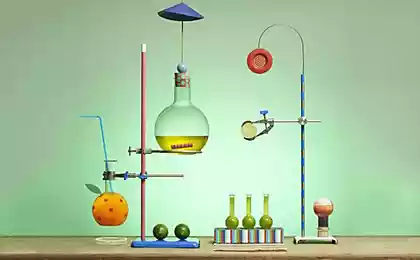854
10 science questions that everybody should know the answer
Fifty one million five hundred fifty five thousand seven hundred seventy eight
Research is ongoing. The level of education of the population increases. Surrounded by technological marvels, from wearable electronics to communications satellites, we have to be damn smart and understand the science, isn't it? The problem is that we (well not we, but many) terrible ignorant if it comes to fundamental scientific knowledge. Only 53% of people know that the Earth goes around the Sun in a year, and only 59% of people know that the first humans and dinosaurs lived at different times, not as in "the Flintstones". Only 47% of people exactly the answer that 70% of the Earth's surface is covered by water.
Obviously, although we have come a long way, there is still a lot of steps before we achieve universal scientific literacy. But for those of you who are desperately trying to change the subject when someone mentions the Higgs boson, supercomputers, or begins to argue that dinosaurs had feathers, there is a good reason to read this article. This article is about ten scientific questions, the answers to which everyone should know.
Why is the sky blue? Eighty five million four hundred sixty nine thousand six hundred fifty six
We see blue or blue sky, white feathers, clouds or heavy storm clouds. But the blue sky, we still like it better than cloudy. European scientists have found that the light blue part of the spectrum has a positive effect on emotions, making us more responsive to emotional stimuli and to adapt to emotional challenges.
But I digress. The sky appears blue because of the so-called scattering effect. Sunlight must pass through the earth's atmosphere filled with gases and particles which are the barriers that hits the sunlight. If you've ever held a prism, you know that light consists of heaps of different colors, each of which has a different wavelength. The blue color wavelength is relatively short, so it gets through the filter more easily than colors with larger wavelengths, and as a result dispersed more widely as it passes through the atmosphere. This is why the sky appears blue when the Sun is high in the sky.
At sunrise and sunset, however, sunlight must travel a longer distance to reach their position. This negates the advantage of the wavelengths of blue color and allows us to see other colors — often red, orange or yellow.
You may ask, why is the sky not purple? The purple wavelength is even shorter. But the solar spectrum is uneven, and purple colors in it is less the eye more sensitive to blue than to purple.
What is the age of the Earth? Eighty seven million four hundred fifty eight thousand seven hundred fifty four
Probably none of the New Year on our planet is not complete when someone say seriously: "I can't believe that the Earth turns 2015 years old!". Or 2016, or 2017... the Real age of the Earth has long been a subject of fierce disputes. In 1654, a scholar named John Lightfoot, whose calculation was based on the biblical Book of Genesis, proclaimed that the Earth was created at 9 am on Mesopotamian time, on 26 October, 4004 BC, In the late 1700s, the scientist Comte de Buffon heated they created a small copy of the planet and measured the rate at which it cooled, and based on these data estimated the age of the Earth at 75,000 years. In the 19th century physicist Lord Kelvin determined the age of the Earth at 20-40 million years.
But all that's gone along with the discovery of radioactivity. The subsequent calculations showed the speed with which decay different radioactive substances. Earth scientists have used this knowledge to determine the age of rocks Earth's, as well as samples from meteorites and rocks brought from the moon by astronauts. They looked at the state of decay of lead isotopes from rocks, and then compared with a scale which showed how to change the isotopes of lead with time. Earth was formed about 4,54 billion years ago with an accuracy of less than one percent.
How natural selection works? Five million nine hundred eighty three thousand one hundred forty three
As the age of the Earth, the theory of evolution — first developed by biologist Charles Darwin in the mid 1800-ies — a topic that people don't know, but love to talk. In our time, the opponents of the theory of evolution trying to remove it from the curriculum in schools or to the children studied "the science of creation" in the appendage to the theory of evolution.
And there's one idea, for which cling to opponents of evolution: natural selection, the Central concept of Darwin. To understand this idea is quite simple. The nature of mutations — that is, a permanent change of the genetic program of organisms, which later will differentiate the view from his predecessor, — occur by chance. But evolution, a long process in which animals and plants have undergone many changes over many generations, is not accidental. As a rule, changes in organisms become more common over time if help the organism survive and reproduce.
For example, imagine that some beetles are green, but due to mutation become brown. The brown beetles blend in with the environment better than green, so they rarely eat birds. They survive more, they are reproduced in larger quantities, and these changes take is not temporary, but permanent in nature. Over time, the population of beetles will be brown. But this is the simplest option. In practice, natural selection takes the basis of average, rather than specific representatives, and to highlight this process is not very simple.
Will go out if the Sun ever? Forty five million four hundred eighty nine thousand seven hundred sixty four
If you think that the Sun person ceases to Shine, when he's going through a rough time in my life, in reality it is not so. The irony is that the reality around us — the sunlight, the singing of the birds more durable than our fragile feelings. Unless you were born 5.5 billion years later. At this moment the Sun and the other star is like a gigantic fusion reactor, will exhaust all the hydrogen in its core and starts to burn hydrogen in the surrounding layers.
This will be the beginning of the end of the Sun — the core will shrink and its outer layers expand and the star becomes a red giant. In the final flash of the Sun will roast the Solar system with a blast of heat that turned into a heavenly sauna even cool neighborhood of Pluto and the Kuiper belt. The inner planets, including Earth, would be socosani a dying giant or turn into ashes.
However, if people do not colonize the Solar system or other stars, nobody knows about this final hell. The sun has already lived half of its life period, is gradually heated, and after a billion years will be 10% more. Increase of solar radiation is enough to vaporize all the earth's oceans, leaving us without water and other pleasures of life.
How do magnets work? Twelve million nine hundred fifty thousand two hundred thirty three
For a long time magnets were something like miracles. And it's sad, because to understand their principle of operation is quite simple. A magnet is any object or material that has a magnetic field. That is a lot of electrons in it are sailing in the same direction. Electrons like to form pairs, and in iron, for example, there are many besarnya electrons, which are easy to tie up on some beer. Therefore, the object of solid iron or even with a large amount of iron will be attracted to a sufficiently powerful magnet. Substances and objects attracted to magnets are called ferromagnets.
Humans have known about magnetism since time immemorial. The nature of the magnets meet, and medieval travelers have learned to magnetize a steel arrows of compasses, that is creating its own magnetic field. Such magnets were not very strong, but in the 20th century, scientists have developed new materials and charging devices that led to the creation of powerful permanent magnets. You can create an electromagnet from a piece of iron by wrapping it with wire and attaching the ends to the poles of a large battery.
What causes a rainbow? Twelve million four hundred eighty eight thousand seven hundred thirty one
There is something special about this atmospheric phenomenon that evokes awe in people since ancient times. In the Book of Genesis, the Lord put a rainbow in the sky after the Great flood and told Noah that it was "a sign of a Covenant between Me and the earth." The ancient Greeks went further and decided that a rainbow is the goddess Irida. However, her figure was a sinister — she declared war and retribution. For centuries great minds, from Aristotle to Descartes, was trying to figure out which process generates the colours of the rainbow.
Now, of course, a scientist is well known. Rainbow cause drops of water that remain suspended in the atmosphere after a good downpour. The density of the droplets is different from the density of the surrounding air, because when the sunlight hits them, they act as tiny prisms, breaking light into its component wavelengths, and then reflecting them back. Born arc with bands of colors of the visible spectrum that we see. As the droplet must reflect light for us to see a rainbow, you need to be back to the sun. Also you need to look from the ground at an angle of about 40 degrees is the angle of deflection of the rainbow, that is, the angle at which it refracts sunlight. It is also interesting that, while in the plane, you can see a rainbow in the form of a disk, not the arc.
What is the theory of relativity? Fifty one million four hundred sixty nine thousand seven hundred forty two
When someone mentions the "theory of relativity" usually refers to two theories, special and General, developed by physicist albert Einstein in the early 1900's. Regardless of the extent of our worship of Einstein, the people far from science, know little of his theories. Einstein himself came up with a way of explanation: "When a man sits with a pretty girl for an hour, it seems that a minute passed. But let him sit on a hot stove for a minute, and it seems to him longer than an hour. Everything is relative".
Everything seems to be clear, although the details, of course, more complicated. Before Einstein, all largely believed that time and space are fixed and monotonous, never changing, from what point on Earth you could watch. But Einstein used math to prove that the absolute view of things is an illusion. In fact, space and time: the space can shrink, expand, twist, and time flows at different speeds depending on the speed of the object or the strength of the gravitational field.
In addition, the manifestation of space and time may depend on the observation point of the person. For example, imagine that you are watching on the old ticking clock. Now place this clock in Earth orbit so that they moved with great speed compared to your position on Earth. The clock in orbit runs slower.
The clock is slower because of the phenomenon of "time dilation". Space and time actually are parts of one whole of space-time, which can be distorted by gravity and acceleration. Because if the object moves very fast or it affects a very powerful gravitational field, time for that object will go slower than an object that is not subjected to the same impact. With the help of mathematical calculations it is possible to predict how to slow down time for fast moving objects.
This probably sounds weird. But it's true. GPS satellites depend on accurate measurements of time and make a map of the Earth, is a good example. The satellites fly around the planet at speeds of approximately 14,000 kilometers per hour, and if engineers didn't adjust hours, taking into account relativity, then the next day Google maps was wrong would be almost 10 kilometres during positioning.
Why are bubbles round? Ninety eight million one hundred sixty nine thousand six hundred thirteen
Yes, bubbles are not always perfectly round, as you might have noticed in one of them cheated. But bubbles tend to the spherical form, and you can see that even the longest of them tend to become round. The fact that bubbles are essentially thin layers of liquid molecules hold due to a phenomenon called cohesion. This creates a surface tension barrier which does not allow objects to penetrate it. But this is not the only force that acts on this layer. Outside pressured air molecules. The most effective way for the liquid layer to resist those forces is to take the most compact shape, which is a sphere, calculating the ratio of the volume to the area.
Remarkably, scientists have learned to do non-circular bubbles cubic, rectangular (pulling a thin layer of liquid on a wire frame), what you want.
What is it made of clouds? Seventeen million three hundred sixty one thousand nine hundred ninety six
I hope that will not disappoint, but the clouds really is not the ice cream mixture and angelic feathers. Cloud is a visible mass of water droplets or ice crystals or a mixture of both that is suspended above the Ground. Clouds occur when rising moist, warm air. When he rises higher and reaches the cold zone, the warm air cools, the water vapor condenseries in tiny water droplets or ice crystals, depending on temperature. These drops and crystals remain knocked together by the principle of cohesion, which we mentioned just above. Thus was born the cloud. Some clouds are thicker than others because they have a higher density of water droplets.
The cloud is a key part of the hydrological cycle of our planet, in which water constantly moves between surface and atmosphere, changing between liquid, solid and gaseous state. If not this cycle of life on our planet could not have been possible.
In 1803, the meteorologist Luke Howard identified four major classification of clouds, which now have Russian and Latin names. Cumulus, or Cumulus clouds are piled up lumpy clouds that we often see in the sky. Cirrus, Cirrus clouds, which means "hair" in Latin, is a lightweight feathers on top, as thin as strands of hair. Flat and plain the clouds are layered stratus, meaning "layer" in Latin. There is also a nimbus cloud, low and grey rain clouds. However, subspecies and varieties of clouds, and their mixtures a little more.
Why water evaporates at room temperature? Sixty five million eight hundred forty six thousand five hundred thirty
We humans tend to think of reality as a good stable place, where different things are in their places, unless we want to move them. But the reality is different. If you look at water at the molecular level, the molecules will look like a pack of puppies that are fighting for the best position in the belly of the boat. When in the air going to a lot of water vapor, the molecules bump into the surface and stick to it, with the result that on the outside of a cold drink on a humid day condensation forms.
Conversely, when the air is dry, the water molecules in your Cup can stick to other molecules floating in the air. This process is called evaporation. If the air is dry enough, more molecules will go from the Cup to the air, rather than fall out of the air in the Cup. Over time, the water will lose more and more of the molecules, and ultimately you will find yourself with an empty Cup.
The ability of the molecules from liquid to jump up in the air and stick to it is called the vapor pressure, because the jumping molecules exert a force, as well as gas or solid substance that presses on something. Different liquids have different vapour pressures. The acetone, for example, this rate is high, meaning it easily evaporates. Olive oil, conversely, has a low vapour pressure and is unlikely to evaporate at room temperature.published
Source: hi-news.ru
Research is ongoing. The level of education of the population increases. Surrounded by technological marvels, from wearable electronics to communications satellites, we have to be damn smart and understand the science, isn't it? The problem is that we (well not we, but many) terrible ignorant if it comes to fundamental scientific knowledge. Only 53% of people know that the Earth goes around the Sun in a year, and only 59% of people know that the first humans and dinosaurs lived at different times, not as in "the Flintstones". Only 47% of people exactly the answer that 70% of the Earth's surface is covered by water.
Obviously, although we have come a long way, there is still a lot of steps before we achieve universal scientific literacy. But for those of you who are desperately trying to change the subject when someone mentions the Higgs boson, supercomputers, or begins to argue that dinosaurs had feathers, there is a good reason to read this article. This article is about ten scientific questions, the answers to which everyone should know.
Why is the sky blue? Eighty five million four hundred sixty nine thousand six hundred fifty six
We see blue or blue sky, white feathers, clouds or heavy storm clouds. But the blue sky, we still like it better than cloudy. European scientists have found that the light blue part of the spectrum has a positive effect on emotions, making us more responsive to emotional stimuli and to adapt to emotional challenges.
But I digress. The sky appears blue because of the so-called scattering effect. Sunlight must pass through the earth's atmosphere filled with gases and particles which are the barriers that hits the sunlight. If you've ever held a prism, you know that light consists of heaps of different colors, each of which has a different wavelength. The blue color wavelength is relatively short, so it gets through the filter more easily than colors with larger wavelengths, and as a result dispersed more widely as it passes through the atmosphere. This is why the sky appears blue when the Sun is high in the sky.
At sunrise and sunset, however, sunlight must travel a longer distance to reach their position. This negates the advantage of the wavelengths of blue color and allows us to see other colors — often red, orange or yellow.
You may ask, why is the sky not purple? The purple wavelength is even shorter. But the solar spectrum is uneven, and purple colors in it is less the eye more sensitive to blue than to purple.
What is the age of the Earth? Eighty seven million four hundred fifty eight thousand seven hundred fifty four
Probably none of the New Year on our planet is not complete when someone say seriously: "I can't believe that the Earth turns 2015 years old!". Or 2016, or 2017... the Real age of the Earth has long been a subject of fierce disputes. In 1654, a scholar named John Lightfoot, whose calculation was based on the biblical Book of Genesis, proclaimed that the Earth was created at 9 am on Mesopotamian time, on 26 October, 4004 BC, In the late 1700s, the scientist Comte de Buffon heated they created a small copy of the planet and measured the rate at which it cooled, and based on these data estimated the age of the Earth at 75,000 years. In the 19th century physicist Lord Kelvin determined the age of the Earth at 20-40 million years.
But all that's gone along with the discovery of radioactivity. The subsequent calculations showed the speed with which decay different radioactive substances. Earth scientists have used this knowledge to determine the age of rocks Earth's, as well as samples from meteorites and rocks brought from the moon by astronauts. They looked at the state of decay of lead isotopes from rocks, and then compared with a scale which showed how to change the isotopes of lead with time. Earth was formed about 4,54 billion years ago with an accuracy of less than one percent.
How natural selection works? Five million nine hundred eighty three thousand one hundred forty three
As the age of the Earth, the theory of evolution — first developed by biologist Charles Darwin in the mid 1800-ies — a topic that people don't know, but love to talk. In our time, the opponents of the theory of evolution trying to remove it from the curriculum in schools or to the children studied "the science of creation" in the appendage to the theory of evolution.
And there's one idea, for which cling to opponents of evolution: natural selection, the Central concept of Darwin. To understand this idea is quite simple. The nature of mutations — that is, a permanent change of the genetic program of organisms, which later will differentiate the view from his predecessor, — occur by chance. But evolution, a long process in which animals and plants have undergone many changes over many generations, is not accidental. As a rule, changes in organisms become more common over time if help the organism survive and reproduce.
For example, imagine that some beetles are green, but due to mutation become brown. The brown beetles blend in with the environment better than green, so they rarely eat birds. They survive more, they are reproduced in larger quantities, and these changes take is not temporary, but permanent in nature. Over time, the population of beetles will be brown. But this is the simplest option. In practice, natural selection takes the basis of average, rather than specific representatives, and to highlight this process is not very simple.
Will go out if the Sun ever? Forty five million four hundred eighty nine thousand seven hundred sixty four
If you think that the Sun person ceases to Shine, when he's going through a rough time in my life, in reality it is not so. The irony is that the reality around us — the sunlight, the singing of the birds more durable than our fragile feelings. Unless you were born 5.5 billion years later. At this moment the Sun and the other star is like a gigantic fusion reactor, will exhaust all the hydrogen in its core and starts to burn hydrogen in the surrounding layers.
This will be the beginning of the end of the Sun — the core will shrink and its outer layers expand and the star becomes a red giant. In the final flash of the Sun will roast the Solar system with a blast of heat that turned into a heavenly sauna even cool neighborhood of Pluto and the Kuiper belt. The inner planets, including Earth, would be socosani a dying giant or turn into ashes.
However, if people do not colonize the Solar system or other stars, nobody knows about this final hell. The sun has already lived half of its life period, is gradually heated, and after a billion years will be 10% more. Increase of solar radiation is enough to vaporize all the earth's oceans, leaving us without water and other pleasures of life.
How do magnets work? Twelve million nine hundred fifty thousand two hundred thirty three
For a long time magnets were something like miracles. And it's sad, because to understand their principle of operation is quite simple. A magnet is any object or material that has a magnetic field. That is a lot of electrons in it are sailing in the same direction. Electrons like to form pairs, and in iron, for example, there are many besarnya electrons, which are easy to tie up on some beer. Therefore, the object of solid iron or even with a large amount of iron will be attracted to a sufficiently powerful magnet. Substances and objects attracted to magnets are called ferromagnets.
Humans have known about magnetism since time immemorial. The nature of the magnets meet, and medieval travelers have learned to magnetize a steel arrows of compasses, that is creating its own magnetic field. Such magnets were not very strong, but in the 20th century, scientists have developed new materials and charging devices that led to the creation of powerful permanent magnets. You can create an electromagnet from a piece of iron by wrapping it with wire and attaching the ends to the poles of a large battery.
What causes a rainbow? Twelve million four hundred eighty eight thousand seven hundred thirty one
There is something special about this atmospheric phenomenon that evokes awe in people since ancient times. In the Book of Genesis, the Lord put a rainbow in the sky after the Great flood and told Noah that it was "a sign of a Covenant between Me and the earth." The ancient Greeks went further and decided that a rainbow is the goddess Irida. However, her figure was a sinister — she declared war and retribution. For centuries great minds, from Aristotle to Descartes, was trying to figure out which process generates the colours of the rainbow.
Now, of course, a scientist is well known. Rainbow cause drops of water that remain suspended in the atmosphere after a good downpour. The density of the droplets is different from the density of the surrounding air, because when the sunlight hits them, they act as tiny prisms, breaking light into its component wavelengths, and then reflecting them back. Born arc with bands of colors of the visible spectrum that we see. As the droplet must reflect light for us to see a rainbow, you need to be back to the sun. Also you need to look from the ground at an angle of about 40 degrees is the angle of deflection of the rainbow, that is, the angle at which it refracts sunlight. It is also interesting that, while in the plane, you can see a rainbow in the form of a disk, not the arc.
What is the theory of relativity? Fifty one million four hundred sixty nine thousand seven hundred forty two
When someone mentions the "theory of relativity" usually refers to two theories, special and General, developed by physicist albert Einstein in the early 1900's. Regardless of the extent of our worship of Einstein, the people far from science, know little of his theories. Einstein himself came up with a way of explanation: "When a man sits with a pretty girl for an hour, it seems that a minute passed. But let him sit on a hot stove for a minute, and it seems to him longer than an hour. Everything is relative".
Everything seems to be clear, although the details, of course, more complicated. Before Einstein, all largely believed that time and space are fixed and monotonous, never changing, from what point on Earth you could watch. But Einstein used math to prove that the absolute view of things is an illusion. In fact, space and time: the space can shrink, expand, twist, and time flows at different speeds depending on the speed of the object or the strength of the gravitational field.
In addition, the manifestation of space and time may depend on the observation point of the person. For example, imagine that you are watching on the old ticking clock. Now place this clock in Earth orbit so that they moved with great speed compared to your position on Earth. The clock in orbit runs slower.
The clock is slower because of the phenomenon of "time dilation". Space and time actually are parts of one whole of space-time, which can be distorted by gravity and acceleration. Because if the object moves very fast or it affects a very powerful gravitational field, time for that object will go slower than an object that is not subjected to the same impact. With the help of mathematical calculations it is possible to predict how to slow down time for fast moving objects.
This probably sounds weird. But it's true. GPS satellites depend on accurate measurements of time and make a map of the Earth, is a good example. The satellites fly around the planet at speeds of approximately 14,000 kilometers per hour, and if engineers didn't adjust hours, taking into account relativity, then the next day Google maps was wrong would be almost 10 kilometres during positioning.
Why are bubbles round? Ninety eight million one hundred sixty nine thousand six hundred thirteen
Yes, bubbles are not always perfectly round, as you might have noticed in one of them cheated. But bubbles tend to the spherical form, and you can see that even the longest of them tend to become round. The fact that bubbles are essentially thin layers of liquid molecules hold due to a phenomenon called cohesion. This creates a surface tension barrier which does not allow objects to penetrate it. But this is not the only force that acts on this layer. Outside pressured air molecules. The most effective way for the liquid layer to resist those forces is to take the most compact shape, which is a sphere, calculating the ratio of the volume to the area.
Remarkably, scientists have learned to do non-circular bubbles cubic, rectangular (pulling a thin layer of liquid on a wire frame), what you want.
What is it made of clouds? Seventeen million three hundred sixty one thousand nine hundred ninety six
I hope that will not disappoint, but the clouds really is not the ice cream mixture and angelic feathers. Cloud is a visible mass of water droplets or ice crystals or a mixture of both that is suspended above the Ground. Clouds occur when rising moist, warm air. When he rises higher and reaches the cold zone, the warm air cools, the water vapor condenseries in tiny water droplets or ice crystals, depending on temperature. These drops and crystals remain knocked together by the principle of cohesion, which we mentioned just above. Thus was born the cloud. Some clouds are thicker than others because they have a higher density of water droplets.
The cloud is a key part of the hydrological cycle of our planet, in which water constantly moves between surface and atmosphere, changing between liquid, solid and gaseous state. If not this cycle of life on our planet could not have been possible.
In 1803, the meteorologist Luke Howard identified four major classification of clouds, which now have Russian and Latin names. Cumulus, or Cumulus clouds are piled up lumpy clouds that we often see in the sky. Cirrus, Cirrus clouds, which means "hair" in Latin, is a lightweight feathers on top, as thin as strands of hair. Flat and plain the clouds are layered stratus, meaning "layer" in Latin. There is also a nimbus cloud, low and grey rain clouds. However, subspecies and varieties of clouds, and their mixtures a little more.
Why water evaporates at room temperature? Sixty five million eight hundred forty six thousand five hundred thirty
We humans tend to think of reality as a good stable place, where different things are in their places, unless we want to move them. But the reality is different. If you look at water at the molecular level, the molecules will look like a pack of puppies that are fighting for the best position in the belly of the boat. When in the air going to a lot of water vapor, the molecules bump into the surface and stick to it, with the result that on the outside of a cold drink on a humid day condensation forms.
Conversely, when the air is dry, the water molecules in your Cup can stick to other molecules floating in the air. This process is called evaporation. If the air is dry enough, more molecules will go from the Cup to the air, rather than fall out of the air in the Cup. Over time, the water will lose more and more of the molecules, and ultimately you will find yourself with an empty Cup.
The ability of the molecules from liquid to jump up in the air and stick to it is called the vapor pressure, because the jumping molecules exert a force, as well as gas or solid substance that presses on something. Different liquids have different vapour pressures. The acetone, for example, this rate is high, meaning it easily evaporates. Olive oil, conversely, has a low vapour pressure and is unlikely to evaporate at room temperature.published
Source: hi-news.ru
Let's not be fanatics. About eating habits and not only.
Quickly get rid of unpleasant sensations: 15 tips for all occasions
























